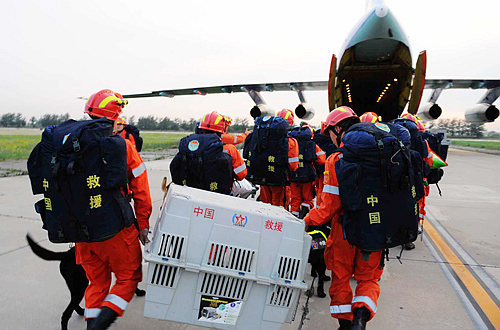|
 |
|
LET'S GO: CISAR members assemble at Beijing Nanyuan Airport before departing for earthquake-stricken areas in Sichuan Province, on May 12, 2008 (WANG JIANHUA) |
Always ready
No matter where he is—at office, at home or on the streets—Song Jianxin, deputy head of the CISAR, always remembers to keep his cellphone on to stay in touch with the China Earthquake Administration. Whenever an earthquake strikes anywhere in the world, Song wants to know, as soon as possible.
When called to duty, CISAR members are required to return to their base in a northern suburb of Beijing immediately and wait for further orders.
Besides the China Earthquake Administration, the team's members are mainly from the military and the armed police force.
Researchers and managerial staff from the China Earthquake Administration are responsible for operation coordination, disaster impact evaluation, technical guidance and daily logistics work. Most rescue personnel are from an engineering corps of the People's Liberation Army, while the General Hospital of the Armed Police Force dispatches medical workers.
While CISAR members all work regular jobs, they are constantly on alert and prepared to set off on a rescue mission at home or abroad within an hour after notification.
At the CISAR's headquarters, supplies such as rescue equipment, water and foods are stored in separate boxes. Upon receiving an order, the items will be transported to the airport. Team members do not need to bother with gathering supplies. All they need to do is rush to the airport when called upon.
Survivors are generally found in the first seven days following an earthquake or most other natural disasters, which is called the "golden rescue time." The CISAR usually carries seven to 10 days of supplies, including water, food, generators and various types of tents, for overseas missions, so that they are self-sufficient.
To operate efficiently, the CISAR needs support from a number of government agencies such as the Ministry of Foreign Affairs and the Civil Aviation Administration of China. A coordinating mechanism was set up immediately after the CISAR was founded. When a disaster strikes, each of these agencies plays a role.
Good communication with these agencies enables the CISAR to respond to disasters quickly. Take the 2010 Haiti earthquake rescue mission for example. "From the moment we received the message, it took us only 3.5 hours to get ready," Song said. "Fifteen tons of supplies were ready to go in a little over three hours, and 33 hours later, we arrived at the disaster area that is about 10,000 km away from Beijing."
Armed to the teeth
China is an earthquake-prone country. Rapid urbanization comes with increased population density and property concentration, making disasters more damaging.
"In the past, rescues were performed using simple tools and techniques which are no longer adequate to deal with rescue work in modern cities," Yin said.
"From its inception, the CISAR aimed to be on par with the rescue teams of developed countries," he said.
Before equipping the CISAR, the China Earthquake Administration carefully studied the equipment used by foreign rescue teams. It bought internationally advanced search, rescue, communication and medical equipment for the CISAR, including portable equipment carried by team members, logistics and supply equipment and sniffer dogs.
The CISAR's equipment is the best there is. The team uses light-weight cutting sheers that are strong enough to cut steel with a diameter of 30 mm and plate-sized air cushions that can lift objects weighing as much as a ton. Its maritime satellite workstations keep team members in the field in touch with commanding agencies.
"Three types of life detectors are used by CISAR members in the search and rescue process," said Wang Zhiqiu, an official with the China Earthquake Administration. One is a pliable snake-like pipe with a tiny video camera on its tip. The soft pipe can get into finger-sized holes and twist freely in small openings, sending pictures back. Team members said it is like a gastroscope for rubble. It can locate buried people and show the "landscape" around the victims.
| 